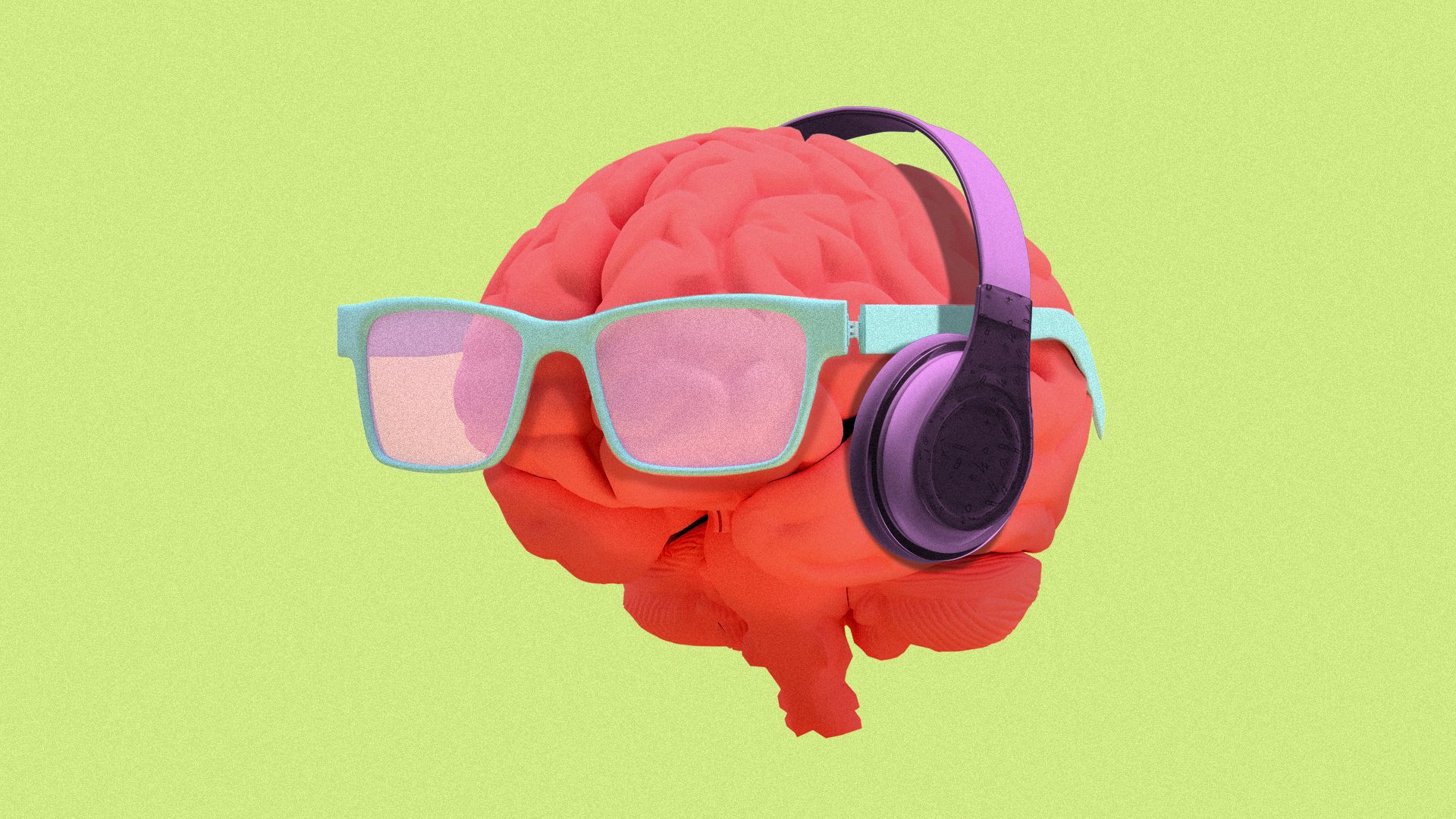| | | | | | | Presented By Deloitte | | | | Axios What's Next | | By Jennifer A. Kingson, Joann Muller and Erica Pandey ·Feb 23, 2022 | | More people are adding "green skills" to their resumes, but not enough to satisfy the soaring demand in the fight against climate change, Joann Muller writes. - And just because you're wearing headphones doesn't mean you're tuning everything out, Erica Pandey explains.
- Stay on top of breaking news in Ukraine with Axios World, by Dave Lawler.
- Email us at whatsnext@axios.com.
Today's Smart Brevity count: 1,122 words ... 4 minutes. | | | | | | 1 big thing: the green talent gap |  | | | Illustration: Sarah Grillo/Axios | | | | Demand for "green talent" is expanding across all industries — not just in what we think of as environmental sectors — but there aren't enough workers with the skills to fill those positions, according to new research from LinkedIn, Joann writes. Why it matters: Companies and government leaders will have to step up efforts to equip workers with the skills needed to help employers be more environmentally friendly and achieve their ambitious climate goals. The big picture: The nature of work is changing, not just where or how people do their jobs, but also the type of work they're doing in response to climate change. - "The Great Reshuffle," as LinkedIn calls it, has only accelerated since the pandemic.
- The skills workers will need by 2025 to perform the same jobs will change by about 40%, and that doesn't even account for the new jobs being created by the global shift to a green economy, the company says.
- Green jobs tend to go "hand in hand" with technology, LinkedIn's chief economist, Karin Kimbrough, tells Axios.
- "Those two are the twin transformers of the jobs market. Things are getting greener and more digital."
What's happening: Hiring for green skills grew globally by almost 40% between 2016-2021, but demand will soon outpace supply, Kimbrough writes in a new blog post. - While job postings requiring green skills grew at 8% annually over the past five years, the share of green talent has grown at roughly 6% annually in the same period.
Green jobs include more than just solar panel installers and sustainability consultants. - Some fast-growing green jobs involve broader roles like compliance manager, facilities manager or technical sales rep.
Meanwhile, more job seekers are listing green skills like ecosystem management, environmental policy and pollution prevention on their resumes. - But green skills can include any abilities or knowledge that people can use to do their jobs in a greener way, notes Kimbrough.
- "It's everything from sustainable fashion — making fashion from sustainable materials — to architects thinking about how do I create a building that uses more natural light so I don't have to cool it as much using air conditioning?"
- "All of these things are elements of the green world of work that is coming towards us, or we are moving towards."
The bottom line: The shift to a green economy will require a green talent transition too. Share this story |     | | | | | | 2. Charted: Cities leading economic recovery |  Data: EIG; Chart: Axios Visuals The big cities on the coasts don't crack the top nine metros leading the post-pandemic jobs recovery, according to a new report from the Economic Innovation Group. The big picture: Superstar metros such as New York, Los Angeles, San Francisco and D.C. are still magnets for job growth and talent, but a slew of smaller cities are joining their ranks, Erica writes. What's happening: "The primary reason why these metros are leading the recovery is that they were seeing very robust job growth in the two years prior to the pandemic," says August Benzow, research lead at EIG. - "The pandemic itself was just a bump in the road. It didn't knock them off their strong trajectories."
But, but, but: Even these hot growth metros aren't immune to pandemic pain. - "Despite the strong performance of these metros, all of them except Salt Lake City still have significantly fewer leisure and hospitality jobs than they did before the pandemic," Benzow notes.
- "And some are doing very well in some sectors and less well in other sectors," he says. "Phoenix, for example, has 26,090 fewer manufacturing jobs than it did in December 2019, but has gained 172,030 construction jobs."
|     | | | | | | 3. Worries of a potential 3G meltdown |  | | | Illustration: Sarah Grillo/Axios | | | | AT&T's shutdown of its 3G network this week has sparked fears that home security systems, medical alert monitors and a range of other devices will stop working, Margaret Harding McGill writes. Why it matters: Carriers have previously retired networks, but this transition is proving more complicated because the pandemic hindered companies that rely on 3G services from making upgrades. Plus, there are just more devices to manage. - AT&T, T-Mobile and Verizon are all planning to shut down their 3G networks this year to support new 5G services.
What to watch: AT&T says phone coverage will not be affected, but it's not just phones that use the company's 3G network. - 3G-connected cars — including some that are only a few years old — may require software or hardware upgrades, or could lose automatic crash notifications and other features entirely.
- School bus communications and transit tracking systems could also be affected.
Details: An alarm industry group says roughly 2 million devices powering burglar intrusion systems, fire alarms and personal emergency alerts will go offline. What they're saying: "We are heading to alarmaggedon," Harold Feld, senior vice president of tech policy group Public Knowledge, told Axios. The other side: AT&T says it has built a plug-in device to automatically connect 3G alarm service devices to its LTE network, and is using roaming options to help bridge the transition for many connected devices. Read the full story |     | | | | | | A message from Deloitte | | The future of smartwatches and wearable medical tech | | |  | | | | Smartwatches and wearable medical devices that make monitoring health simple and accessible are surging in popularity. Deloitte Global predicts that 320 million will ship worldwide this year. Okay, but: There are doubts over the accuracy and security of these devices. Here's the bottom line. | | | | | | 4. Big Tech's office bet |  | | | Illustration: Brendan Lynch/Axios | | | | Tech companies were among the first to send workers home, and they're likely to have vast numbers of jobs that can be done fully remotely — but they're still betting that offices will be the future, Erica writes. Stunning stat: Tech companies held 36 of the 100 biggest office leases in 2021, up from 18 in 2020, per a new CBRE analysis. - That amounts to 11.4 million square feet of office space.
- In second place is the federal government, which has 5.1 million square feet of the 100 biggest leases — less than half of what the tech industry has.
Overall, office leasing in the U.S. was up nearly 27% last year, CBRE's Manish Kashyap notes. "The tech industry is the big engine there." The bottom line: The fact that some of the most remote-capable companies in the country are gobbling up office space and expecting employees to come back to work in person signals that fully remote work won't be the norm once the pandemic is behind us. Go deeper: Companies might face resistance as they call workers back |     | | | | | | 5. 1 🎧 thing: Voices in your head |  | | | Illustration: Sarah Grillo/Axios | | | | We're more trusting of and more persuaded by things we hear through our headphones, according to a new study from UC San Diego, UCLA and UC Berkeley. Why it matters: That means advertisements and public service announcements people hear when they're listening to something through headphones — like a podcast — might be more persuasive than other ads, the researchers note. - In one experiment, researchers surveyed a group of adults who listened to an audio clip of a mother and daughter talking about their homelessness. Some used headphones and some listened through a speaker.
- Those who used headphones felt more empathy toward the mother and daughter and felt they were more genuine, according to the study.
|     | | | | | | A message from Deloitte | | Mental health apps offer unique potential | | |  | | | | Deloitte Global predicts the popularity of mental health apps could increase by about 20% this year. Why it's important: These apps make mental health support more accessible and are more resistant to disruption than traditional therapies. Explore the potential. | | | | Was this email forwarded to you? Get your daily dose of What's Next magic by signing up for our free newsletter here. |  | Bring the strength of Smart Brevity® to your team — more effective communications, powered by Axios HQ. | | | | | | Axios thanks our partners for supporting our newsletters. If you're interested in advertising, learn more here.
Sponsorship has no influence on editorial content. Axios, 3100 Clarendon Blvd, Suite 1300, Arlington VA 22201 | | | You received this email because you signed up for newsletters from Axios.
Change your preferences or unsubscribe here. | | | Was this email forwarded to you?
Sign up now to get Axios in your inbox. | | | | Follow Axios on social media:    | | | | | |









No comments:
Post a Comment